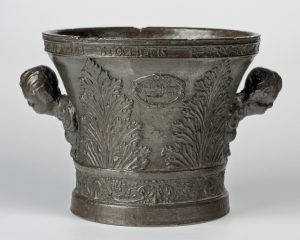
A Stunning Signed and Dated Pharmacy Mortar
This monumental and refined bronze mortar, flared in shape, has a foot adorned with a twisted cord. The body, decorated at the bottom with large acanthus leaves, is embellished, about halfway up, by a double twisted cord; at the same height, in diametrical position, two beautiful heads of young boy facing downwards protrude from both sides, acting as handles to the piece. One side bears the maker’s signature and the date in capital letters: AGOSTINI PERUSINO FECIT A.D. MDCCLIX, while the other side shows a figure of a dancing putto grasping a large Thistle flower, between the letters G and S (probable patron’s initials).

The signature appearing on this beautiful mortar is that of a bronze caster, who made the decorations for the tomb of the bishops in the Perugian cathedral (1765) and the main altar of St. Francesco al Prato church: Niccolò Agostini, a proud artist from Perugia “espertissimo in lavorare di campane, che sono riuscite eccellenti per la pulizia del lavorio, per gli adornamenti e molto più pel suono armonizzante” (very expert in making bells showing excellent quality and decorations and a harmonizing sound), as we can read in the Descrizione della Basilica di San Lorenzo by Galassi (1776); moreover, in 1769 he was commissioned to repair La Lunga, a bell of that same cathedral (Siepi 1822, p. 129).
Mortars are still today a typical symbol of pharmacology, and the large-sized pharmacy mortars like this one, although almost never really used – signs of wear are very rare – were objects of great value and representation, made for the most important apothecaries who exhibited them as emblems at the entrance to their pharmacies. This kind of richly decorated and ‘monumental’ mortar is attested only from the 16th century onwards, and was almost always made in bronze: the best alloy for the apothecary because of its resistance, cohesion and for being non-porous.

The putto, grasping almost certainly a Marian Thistle flower, symbolically stands for the botanical and pharmacological knowledge of medicinal plants: the thistle has been known since ancient times for its anti-poisonous and curative properties, especially for the liver and the galbladder.
The shape of an upturned ‘bell’ mortar with figured handles was set towards the end of the 16th century and became a stable paradigm over the next two centuries, as can be seen in the collection of the Museo Storico Nazionale dell’Arte Sanitaria in Rome and, for example, in a dated mortar in Hamburg originally belonging to ‘IOSEPH DE STOCHETIS PHARMACOPOLA AD SIGNUM VITIS AUREA’.

The decorative repertoire of the mortar presented here, with putti and acanthus leaves taken from the classical style, is typical of Central Italy. Also, while signed and dated mortars are quite common in northern Europe, they are much rarer in Italy: hence the great uniqueness and importance of the present piece, making it an artwork of particular interest.

Niccolò Agostini (documented in Perugia, second half 18th century)
MORTAR
Bronze
1759
Cm 43x 40h
Signed and dated: AGOSTINI PERUSINO FECIT A.D. MDCCLIX
THIS WORK IS NO LONGER AVAILABLE
References: Francesco M. Galassi, Descrizione della Basilica di San Lorenzo (1766); Serafino Siepi, Descrizione topologico-istorica della città di Perugia, Volume 1 (1822), pp. 92, 129; Francesco Santi, ad vocem “Agostini, Antonio”, in Dizionario Biografico degli Italiani, I, 1960; Giorgio Lise, Antichi mortai da farmacia, 1975; Ulrich Middeldorf, Fifty Mortars, 15th-18th Centuries, 1981; E. Launert, Der Morser, 1990; Peta Motture, Bells and Mortars, 2001; D. Banzato, Bronzi del Rinascimento. Collezione Vok, 2004.
© 2013 – 2024 cesatiecesati.com | Please do not reproduce without our expressed written consent
Alessandro Cesati, Via San Giovanni sul Muro, 3 – 20121 Milano – P.IVA: IT06833070151